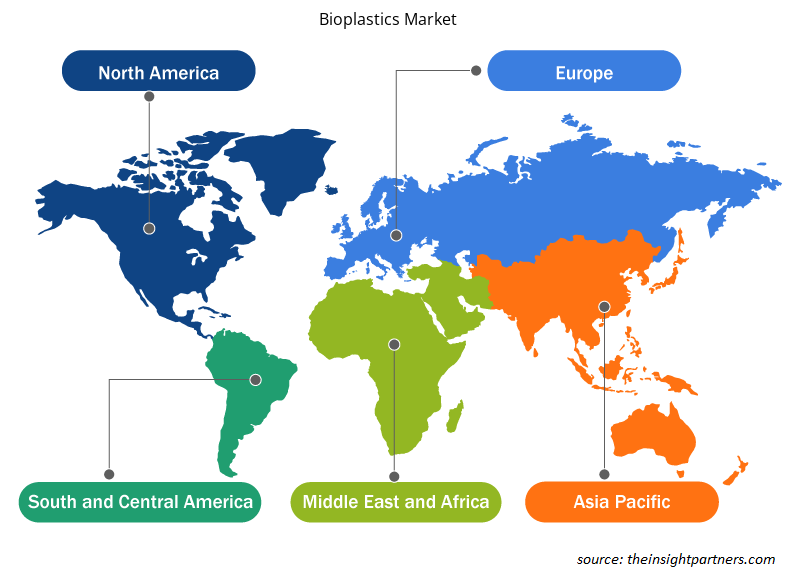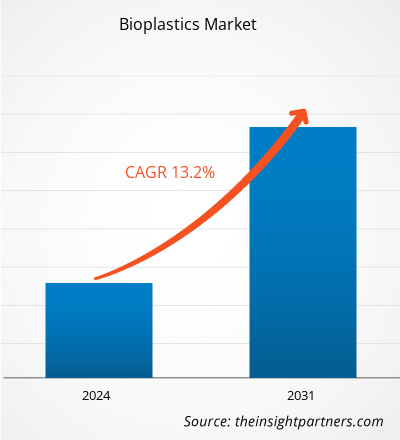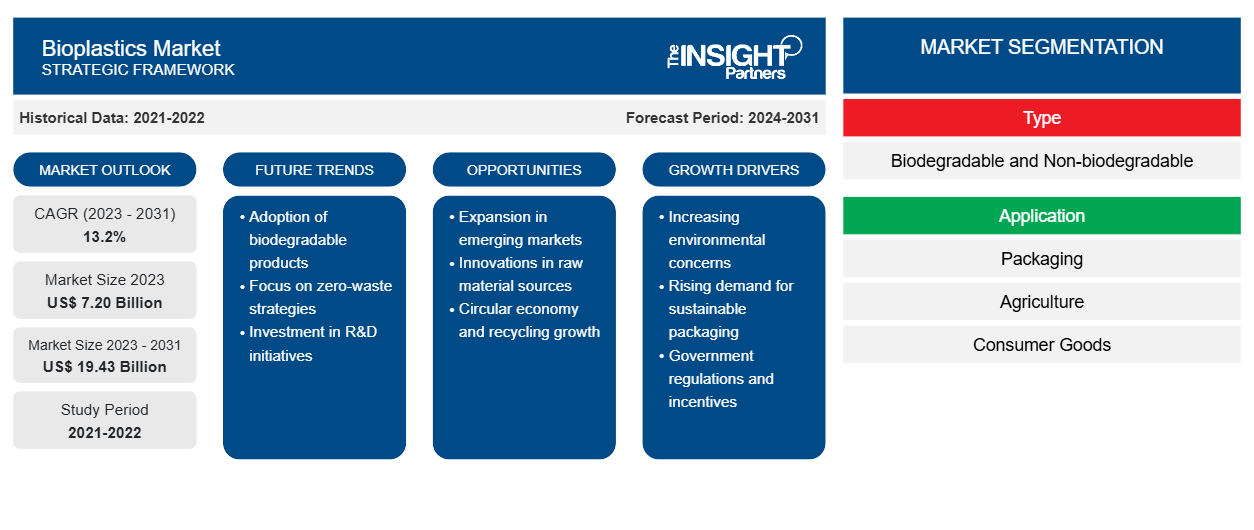Se prevé que el tamaño del mercado de bioplásticos alcance los 19.430 millones de dólares en 2031, frente a los 7.200 millones de dólares en 2023. Se espera que el mercado registre una CAGR del 13,2 % entre 2023 y 2031. Es probable que el creciente enfoque en la innovación y el avance tecnológico sigan siendo tendencias clave en el mercado de bioplásticos.
Análisis del mercado de bioplásticos
Las crecientes preocupaciones ambientales y el esfuerzo global por reducir la contaminación están impulsando la demanda de plásticos biodegradables en el sector de los envases en todo el mundo. Además, se espera que la demanda de bioplásticos en la industria del envasado crezca debido a la creciente necesidad de diferentes productos para el cuidado de la salud. Además, es fácil para los fabricantes fabricar envases de bioplástico porque los envases producidos a partir de biopolímeros generalmente se pueden producir empleando tecnología de procesamiento de plásticos estándar. La creciente demanda de plásticos ecológicos en el sector de los envases es un factor importante que se espera que impulse el crecimiento del mercado de bioplásticos en todo el mundo durante el período de pronóstico.
Panorama del mercado de los bioplásticos
Los bioplásticos son materiales plásticos que se componen de fuentes de biomasa renovables, entre las que se incluyen grasas y aceites vegetales, almidón de maíz, paja, virutas de madera, serrín y desechos alimentarios reciclados, entre otros. Los bioplásticos se están utilizando cada vez más para reducir el problema de los residuos plásticos que están asfixiando al planeta y contaminando el medio ambiente ; junto con esto, la producción de bioplástico requiere un 65% menos de energía que el plástico convencional derivado del petróleo.
Personalice este informe según sus necesidades
Obtendrá personalización en cualquier informe, sin cargo, incluidas partes de este informe o análisis a nivel de país, paquete de datos de Excel, así como también grandes ofertas y descuentos para empresas emergentes y universidades.
-
Obtenga las principales tendencias clave del mercado de este informe.Esta muestra GRATUITA incluirá análisis de datos, desde tendencias del mercado hasta estimaciones y pronósticos.
Factores impulsores y oportunidades del mercado de los bioplásticos
Demanda creciente de bioplásticos en diversos campos de aplicación
La creciente demanda de bioplásticos en diversos campos de aplicación es un factor importante para el mercado de los bioplásticos. Los bioplásticos se utilizan en numerosas industrias de uso final, como la médica, la automotriz y el transporte, el envasado, la agricultura, los bienes de consumo, los textiles, la construcción y otros. En el sector médico, los bioplásticos tienen aplicaciones integrales en el tratamiento de heridas, la ingeniería de tejidos, la administración de medicamentos, los dispositivos ortopédicos y la fabricación de andamios fibrosos y porosos. En el sector automotriz, los bioplásticos ofrecen una menor dependencia de los recursos fósiles, una reducción en el costo de fabricación y una huella de carbono significativamente reducida. Además, los bioplásticos se utilizan para envases rígidos de cosméticos de polvos compactos, cremas, lápices labiales y botellas de bebidas .
Leyes y regulaciones gubernamentales estrictas sobre el uso tradicional del plástico
Numerosos países de todo el mundo han implementado leyes y regulaciones relacionadas con el plástico. Varios países están haciendo esfuerzos para prohibir el plástico de un solo uso y promover alternativas sostenibles. Esto ayudará a mitigar los efectos nocivos para la vida humana y el medio ambiente. Por lo tanto, se espera que las estrictas leyes y regulaciones gubernamentales sobre el uso tradicional del plástico ofrezcan oportunidades más lucrativas para el crecimiento del mercado de bioplásticos.
Análisis de segmentación del informe de mercado de bioplásticos
Los segmentos clave que contribuyeron a la derivación del análisis del mercado de bioplásticos son el tipo y la aplicación.
- Según el tipo, el mercado se segmenta en biodegradables y no biodegradables. El segmento biodegradable tuvo una mayor participación de mercado en 2023.
- Por aplicación, el mercado está segmentado en embalajes, agricultura, bienes de consumo, automoción y transporte, textiles, construcción y edificación, entre otros. El segmento de embalajes tuvo la mayor participación del mercado en 2023.
Análisis de la cuota de mercado de los bioplásticos por geografía
El alcance geográfico del informe del mercado de bioplásticos se divide principalmente en cinco regiones: América del Norte, Asia Pacífico, Europa, Medio Oriente y África, y América del Sur y Central.
El mercado mundial estuvo dominado por Asia Pacífico. Europa es el segundo mayor contribuyente a la participación de mercado mundial de bioplásticos. En América del Norte, los bioplásticos se consumen ampliamente en el sector del embalaje en forma de botellas y bolsas de plástico. Se espera que la producción y el consumo de bioplásticos crezcan en la región, principalmente en aplicaciones de envasado de alimentos. A diferencia de los plásticos tradicionales, los bioplásticos se obtienen de fuentes renovables. La industria automotriz en esta región es una de las industrias más avanzadas a nivel mundial debido a las importantes inversiones en infraestructura, actividades de I+D y nuevas instalaciones de producción. Las biopoliamidas (Bio-PA), el ácido poliláctico (PLA) y el polipropileno de base biológica (Bio-PP) son bioplásticos que se utilizan ampliamente en la fabricación de automóviles. Estos factores están impulsando el crecimiento del mercado de bioplásticos automotrices.
Perspectivas regionales del mercado de bioplásticos
Los analistas de Insight Partners explicaron en detalle las tendencias y los factores regionales que influyen en el mercado de bioplásticos durante el período de pronóstico. Esta sección también analiza los segmentos y la geografía del mercado de bioplásticos en América del Norte, Europa, Asia Pacífico, Oriente Medio y África, y América del Sur y Central.

- Obtenga datos regionales específicos para el mercado de bioplásticos
Alcance del informe sobre el mercado de bioplásticos
| Atributo del informe | Detalles |
|---|---|
| Tamaño del mercado en 2023 | US$ 7.20 mil millones |
| Tamaño del mercado en 2031 | US$ 19,43 mil millones |
| CAGR global (2023 - 2031) | 13,2% |
| Datos históricos | 2021-2022 |
| Período de pronóstico | 2024-2031 |
| Segmentos cubiertos |
Por tipo
|
| Regiones y países cubiertos |
América del norte
|
| Líderes del mercado y perfiles de empresas clave |
|
Densidad de actores del mercado de bioplásticos: comprensión de su impacto en la dinámica empresarial
El mercado de bioplásticos está creciendo rápidamente, impulsado por la creciente demanda de los usuarios finales debido a factores como la evolución de las preferencias de los consumidores, los avances tecnológicos y una mayor conciencia de los beneficios del producto. A medida que aumenta la demanda, las empresas amplían sus ofertas, innovan para satisfacer las necesidades de los consumidores y aprovechan las tendencias emergentes, lo que impulsa aún más el crecimiento del mercado.
La densidad de actores del mercado se refiere a la distribución de las empresas o firmas que operan dentro de un mercado o industria en particular. Indica cuántos competidores (actores del mercado) están presentes en un espacio de mercado determinado en relación con su tamaño o valor total de mercado.
Las principales empresas que operan en el mercado de bioplásticos son:
- Teijin limitada
- Industrias Toray, Inc.
- Sabic
- BASF SE
- PLA Corbion total
- Braskem SA
Descargo de responsabilidad : Las empresas enumeradas anteriormente no están clasificadas en ningún orden particular.

- Obtenga una descripción general de los principales actores clave del mercado de bioplásticos
Noticias y desarrollos recientes del mercado de bioplásticos
El mercado de los bioplásticos se evalúa mediante la recopilación de datos cualitativos y cuantitativos posteriores a la investigación primaria y secundaria, que incluye publicaciones corporativas importantes, datos de asociaciones y bases de datos. A continuación, se incluye una lista de los avances en el mercado de los trastornos del habla y el lenguaje y las estrategias:
- SABIC, líder mundial en la industria química, lanzó hoy una nueva cartera de resinas ULTEM™ de origen biológico que ofrecen beneficios de sostenibilidad y, al mismo tiempo, ofrecen exactamente el mismo alto rendimiento y procesabilidad que los materiales ULTEM actuales. Estos innovadores materiales de polieterimida (PEI) son los primeros polímeros amorfos, renovables y de alto rendimiento certificados disponibles en la industria. (Fuente: SABIC, Noticias y medios/Últimas noticias/octubre de 2021)
- Toray Industries, Inc., anunció hoy que ha desarrollado una fibra de nailon 510 (N510) que incorpora un 100 % de "contenido de polímero sintético de origen biológico", tal como se define en la sección 3.1.5 de la norma ISO 16620-1:2015, la norma internacional para el contenido de origen biológico de los plásticos. Ecodear N510 será la primera fibra de nailon 100 % de origen vegetal de la línea Ecodear de Toray. (Fuente: TORAY INDUSTRIES, INC., Sala de prensa/enero de 2022)
Cobertura y resultados del informe sobre el mercado de bioplásticos
El informe “Tamaño y pronóstico del mercado de bioplásticos (2021-2031)” proporciona un análisis detallado del mercado que cubre las siguientes áreas:
- Tamaño del mercado y pronóstico a nivel global, regional y nacional para todos los segmentos clave del mercado cubiertos bajo el alcance
- Dinámica del mercado, como impulsores, restricciones y oportunidades clave
- Principales tendencias futuras
- Análisis detallado de las cinco fuerzas de Porter y FODA
- Análisis del mercado global y regional que cubre las tendencias clave del mercado, los principales actores, las regulaciones y los desarrollos recientes del mercado.
- Análisis del panorama de la industria y de la competencia que abarca la concentración del mercado, el análisis de mapas de calor, los actores destacados y los desarrollos recientes
- Perfiles detallados de empresas
- Análisis histórico (2 años), año base, pronóstico (7 años) con CAGR
- Análisis PEST y FODA
- Tamaño del mercado, valor/volumen: global, regional y nacional
- Industria y panorama competitivo
- Conjunto de datos de Excel
Informes recientes
Informes relacionados
Testimonios
Razón para comprar
- Toma de decisiones informada
- Comprensión de la dinámica del mercado
- Análisis competitivo
- Información sobre clientes
- Pronósticos del mercado
- Mitigación de riesgos
- Planificación estratégica
- Justificación de la inversión
- Identificación de mercados emergentes
- Mejora de las estrategias de marketing
- Impulso de la eficiencia operativa
- Alineación con las tendencias regulatorias























 Obtenga una muestra gratuita para - Mercado de bioplásticos
Obtenga una muestra gratuita para - Mercado de bioplásticos